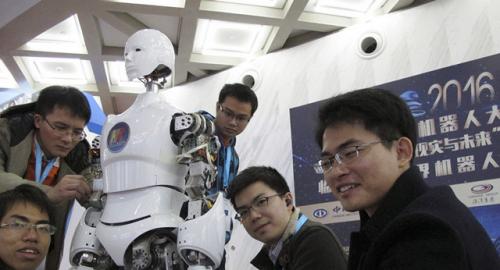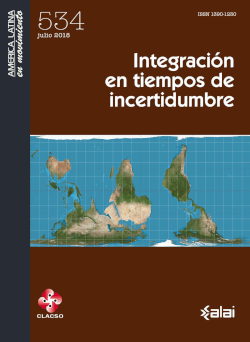Geopolitics of artificial intelligence and digital integration
There is a struggle for the global domination of this new economy, whose principal contenders today are the United States and China and their respective transnational corporations.
- Opinión

| Article published in ALAI’s magazine No. 534: Integración en tiempos de incertidumbre 27/07/2018 |
Over the past two decades, digital technologies have become one of the most dynamic sectors of economic development. This has been much more evident in the last couple of years, with the boom of artificial intelligence (AI) and the Internet of things (IoT) on a widespread basis.
There is now talk of a fourth industrial revolution or “Industry 4.0", which is not only a matter of digital automation of already existing functions and jobs, but of digital transformation. This implies the creation of new models of production and business, on the basis of new capacities that allow for innovation and technological and convergence, mass data processing and machine learning. Among these is the so-called “collaborative economy” with examples from Wikipedia (that claims to be the largest project of knowledge gathering in human history and is based on voluntary collaboration), to Uber (a company that innovated in monetarizing a platform to connect drivers with passengers).
Meanwhile, a struggle has been unleashed lately for the global domination of this new economy, whose principal contenders today are the United States and China and their respective transnational corporations. Europe, Russia and some other countries, although they have some development in AI, have been left well behind the two leaders.
The race to dominate artificial intelligence
This evolution runs alongside an accelerated concentration of control of digital technologies in a handful of transnational mega corporations. So far in this century, this concentration includes, among others, the key infrastructure (such as submarine cables and root servers), end-user operating systems (Windows, Microsoft, MacOS/Apple, Android Google); and the most popular Internet platforms (mainly the so-called GAFA –Google, Apple, Facebook, Amazon). In all of this, the United States dominates, as is evidenced by the fact that the GAFAM (including here Microsoft) already occupy the first places of valorization in the stock-markets, surpassing the oil companies[i]. But China is rapidly gaining new ground, with their own corporations: in particular Alibaba (e-commerce–which has already surpassed Walmart as the biggest retail company in the world), Tencent (provider of Internet services) and the Baidu search engine.
In effect, since 2014, China has been developing a State policy of boosting technological innovation, with support for its major digital enterprises but also a large number of start-ups, throughout the national territory. A year ago, the Council of State released a proposal (See Lee 2017[ii] to become the world’s number one in AI by 2030. A key component of this policy is education, at all levels, to train experts, researchers and qualified workers.
Several studies demonstrate that, with a greater quantity of data to analyze, AI obtains better results. Therefore, China considers that it has at least two comparative advantages:
– a numerous population that constitutes a massive user base that allows them to manage greater quantities of data; and
– a society with similarities to other developing countries, that also have numerous populations.
So their gamble is to capture the AI market principally in these countries, with their greater capacity to develop applications adapted to their particular needs. At the same time, this will signify access to more data and better AI. Alibaba, Baidu and Tencent, among others, are already investing strongly in AI and data mining. For their part, the GAFAM, understanding the technological advantages of China, are investing in the Chinese digital economy. Google, for example, announced last December the opening of an AI research centre in Beijing, with 600 scientists and engineers, the majority of them Chinese.
Some analysts consider the struggle for domination in technology is what is really behind the trade war that the United States has initiated against China. Jorge Castro, ex Secretary of Technological Planning of Argentina, estimates that ultimately, what the United States is seeking is to restrain the investments of US enterprises – principally the GAFAM – in the development of high technology in China.
“China now needs investment that is directed towards the cutting-edge segments of the transnational system of production, with high productivity and intense capacity for the creation of added value, which means essentially that which comes from the United States and Europe, above all Germany”[iii], says Castro. Hence, to confront China, there is no other route for the United States than to establish a balance of power favourable to their vital interests. The analyst adds that: “This is happening in a world that has been fully integrated, and where globalization has acquired a dizzy pace dominated by the instantaneous character of the technological revolution. Therefore, the push for global power is a strategically decisive part of the endeavor for integration. Competition and integration are a single historical phenomenon”.
Towards a Latin American digital project?
In Latin America, the development of AI is mostly embryonic, and in many countries is absent. Nevertheless, in an increasing number of areas, both the private sector and public services and entities contract AI services from transnational corporations. This implies the surrender, often gratuitously, of huge quantities of data that are converted into a source of enrichment for the foreign companies, rather than for the country that provides the data, and in general without any requirement for technological transfer.
Today, when the digital networks are integrated on a world scale and digital goods move freely across borders, the world has been weaving new forms of economic and cultural integration. Latin America is a part of this fabric, but in general in a subordinate role, inasmuch as most countries lack policies of technological sovereignty and, in many cases, adequate conditions of infrastructure, connectivity, data storage and management, investment in innovation, etc. Meanwhile, the technological powers put pressure on States to accept the imposition of “e-commerce” rules that favour the dominant enterprises, as is presently under discussion in the World Trade Organization[iv] and have been included in various negotiations of free trade agreements. The region and its governments would be ill advised to accept such rules that would inhibit their possibilities of developing their own technological capacity.
The Economic Commission for Latin America (CEPAL/ECLAC), for their part, recommend the creation of a Latin American digital common market that would offer our region the opportunity for economic integration that would allow for scaling up and developing networked economies, something that they had not managed to achieve with the old technologies[v]. CEPAL recognizes that various obstacles would have to be overcome in order to achieve such integration, including, among others, the lack of coordination in questions of standards and regulation, in addition to shortcomings in infrastructure and the transport of merchandise. In this sense, a Digital Agenda for Latin America and the Caribbean had been put forward and is under discussion in the framework of eLAC (the regional process that came out of the World Summit on the Information Society, since 2005).
It is worth noting that, even in their moment of greatest progress, the integrationist initiatives such as UNASUR and CELAC barely took account of this issue. That is to say, it has been practically limited to the area of Telecommunications Ministries (the main actors in eLAC), with their priority accent on telecommunications as business and (at a secondary level) digital inclusion. It appears that we are still far from a global understanding of the dimensions and challenges of the new digital era, which would require developing an integral vision that would prioritize the creation of local capacities and technology sovereignty. The potential to weigh upon the world scene would be much greater with regionally agreed policies; without them, Latin America risks regressing towards new forms of dependency.
(Translated for ALAI by Jordan Bishop)
Sally Burch, British-Ecuadorian journalist, is the executive director of the Latin American Information Agency -ALAI-.
[i] According to Forbes magazine, in 2017 the GAFAM were among the 6 corporations with the highest global ranking by stock-market value, www.forbes.com/global2000/list/
[ii] Lee, Amanda. 2017. “World dominance in three steps: China sets out road map to lead in artificial intelligence by 2030”, South China Morning Post, July 21. http://www.scmp.com/tech/enterprises/article/2103568/world-dominance-three-steps-china-sets-out-road-map-lead-artificial
[iii] http://institutocirculomss.com.ar/2018/07/01/la-verdadera-pelea-entre-estados-unidos-y-china-es-por-las-inversiones-en-tecnologia/
[iv] See: Burch, Sally. 2018. “Transnational corporations’ agenda on e-commerce”, June. https://www.alainet.org/en/articulo/193302.
Del mismo autor
- Which digital future? 27/05/2021
- ¿Cuál futuro digital? 28/04/2021
- Desafíos para la justicia social en la era digital 19/06/2020
- É hora de falar de política de dados e direitos econômicos 06/04/2020
- Es hora de hablar de política de datos y derechos económicos 01/04/2020
- It’s time to talk about data politics and economic rights 01/04/2020
- 25 de enero: Primer día de protesta mundial contra la 5G 23/01/2020
- January 25: First global day of protest against 5G 23/01/2020
- « En défense de Julian Assange » 02/12/2019
- "En defensa de Julian Assange" 29/11/2019
Clasificado en
Integración
- Facundo Escobar 14/01/2022
- Eduardo Paz Rada 03/01/2022
- Francisco Eduardo de Oliveira Cunha 03/01/2022
- Adalid Contreras Baspineiro 13/10/2021
- Juan J. Paz-y-Miño Cepeda 21/09/2021
Internet ciudadana
- Nick Bernards 31/03/2022
- Paola Ricaurte 10/03/2022
- Burcu Kilic 03/03/2022
- Shreeja Sen 25/02/2022
- Internet Ciudadana 16/02/2022

